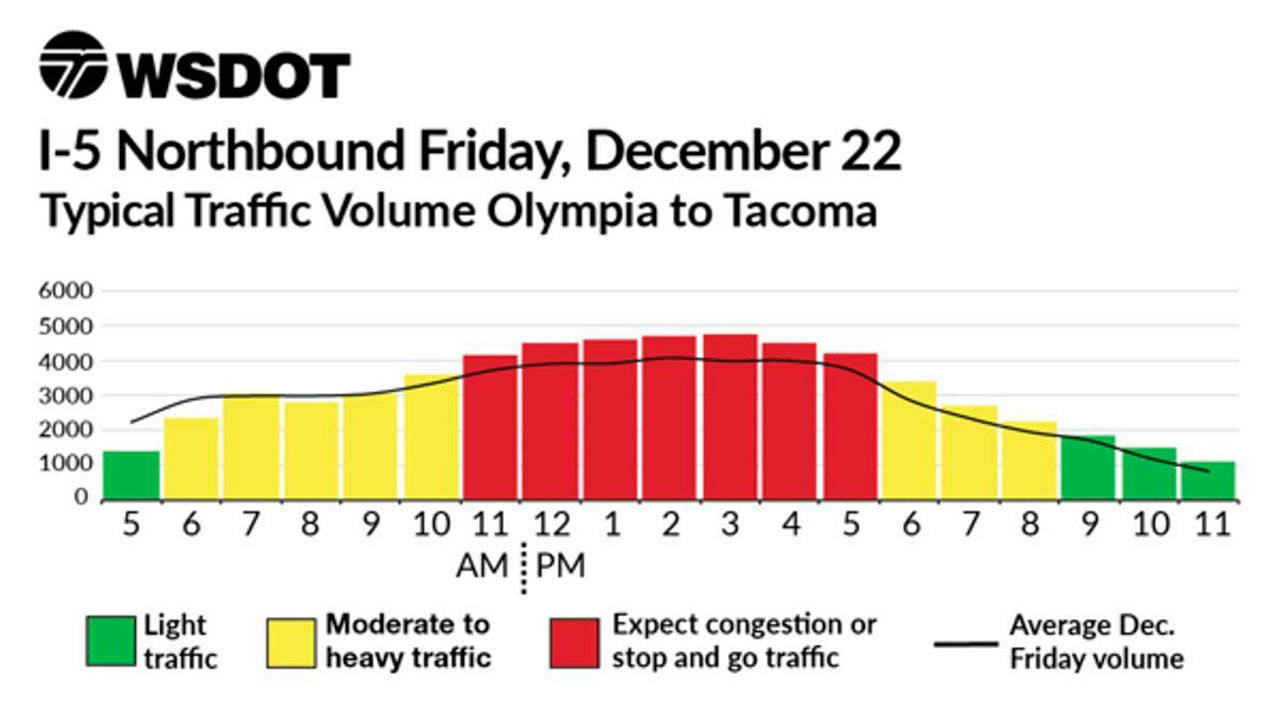No matter what your holiday plans, being prepared for winter conditions and holiday traffic will help make your trip smoother. The Washington State Department of Transportation urges all travelers to “know before you go” and plan ahead for smoother travel.
Three-day Christmas weekends are rare – the last one was in 2006 – but traffic analysts have used historical data to produce travel time charts predicting this year’s heaviest travel times. One note: WSDOT traffic analysts warn that winter weather is unpredictable, so be prepared for snow and ice no matter where you travel and know that a sudden snowstorm can affect the travel time projections.
The agency provides several other tools to help plan holiday travels:
• Visit our online traveler information about traffic, weather and ferry schedules.
• Pre-program 530 AM and 1610 AM to vehicle radios for highway advisory radio alerts.
• Carry chains and other winter driving essentials.
• Check current chain and traction requirements on the WSDOT passes website or by calling 5-1-1, and watch for highway advisory signs.
• Leave extra time for holiday and winter travel, slow down and drive appropriately for conditions. Often crashes or pass closures are due to drivers going too fast or traveling without proper equipment.
MOUNTAIN PASSES
In the mountains, State Route 123 Cayuse Pass (elevation 4,675 feet), State Route 20 North Cascades Highway (elevation 5,477 feet) and Chinook Pass (elevation 5,430 feet) are closed for the winter.
On Snoqualmie Pass (elevation 3,022), you can receive text alerts for pass delays 30 minutes or longer – text “wsdot snoqualmie” to 468311 to subscribe, and “wsdot stop” to unsubscribe.
TOLLS
In the Puget Sound, the State Route 520 bridge will have weekend toll rates on Monday, Dec. 25.
Travel is free on the Interstate 405 express toll lanes on Christmas day, returning to normal toll and HOV requirements from 5 a.m. to 7 p.m. on Tuesday, Dec. 26. I-405 express toll lanes are always free on weekends and evenings.
Out-of-town travelers can learn about toll roads and short-term account options on the Good to Go! visitors page. If renting a vehicle, check with the rental agency about their tolls policy and fees.
I-5 RAMPS TO EASTBOUND I-90 IN SEATTLE CLOSED OVERNIGHT WEDNESDAY, DEC. 20
Drivers heading from Interstate 5 to eastbound Interstate 90 should plan for a slightly longer trip Wednesday night, Dec. 20. Contractor crews working for the Washington State Department of Transportation and Sound Transit will perform tests on the Mount Baker Tunnel operational system.
At 11 p.m. crews will close the ramps from northbound and southbound I-90 to eastbound I-90. Drivers should follow the signed detours and use Fourth Avenue South to access eastbound I-90 during the closure.
Between 11:59 p.m. and 4 a.m., crews will perform up to four rolling slowdowns on eastbound I-90 between I-5 and the Mount Baker Tunnel. Drivers should expect delays of up to 15 minutes while that work occurs.
All lanes and ramps will reopen by 5 a.m. Thursday, December 21.
DARK, RAINY DAYS AHEAD – USE EXTRA CAUTION
The rain and wind return this weekend, and that’s why we’re reminding everyone to be more cautious on the roads.
On both the state and federal level, we’ve set goals of reducing traffic-related fatalities on all roads to zero. Unfortunately, for people walking and bicycling in Washington, serious injuries and fatalities are on the rise recently. We’re offering these safety tips to help reduce the risk of collisions:
Drivers:
• Stop for people in crosswalks — every intersection is a crosswalk. It’s the law.
• Put the phone down.
• Don’t drive impaired.
• Watch for people walking or biking near senior centers, schools, community centers, and other destinations.
• Pass at a safe distance.
• Drive the posted speed limit, or slower if conditions make visibility difficult.
• Use your lights.
People Walking or Bicycling:
• Walk and bike where you can be most visible.
• Take care when crossing.
• Use eye contact and hand signals to communicate.
• Use lights as required and take advantage of lighted crossings.
There is even more information on these safety tips on the WSDOT Blog.


